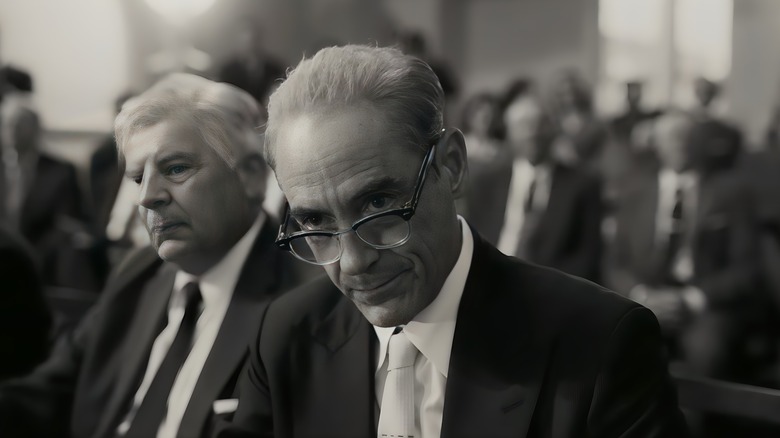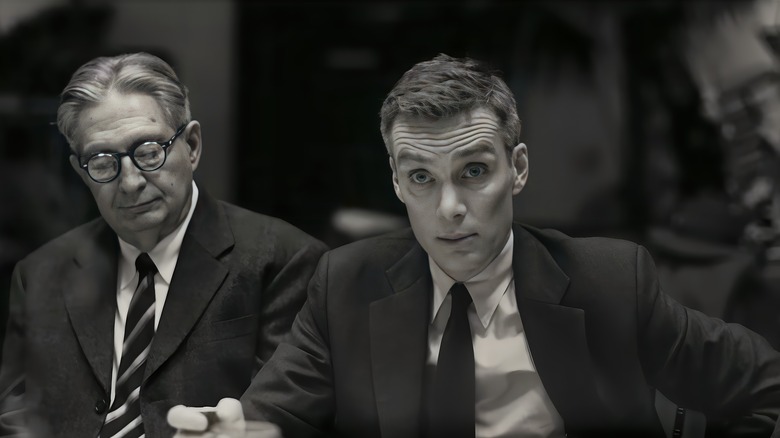Oppenheimer's Timeline And Confusing Flashbacks Explained
Contains spoilers for "Oppenheimer."
In true Christopher Nolan fashion, "Oppenheimer" tells the story of the man behind the world's most deadly invention through a potentially confusing non-linear story structure. A similar method of blurring the lines between what's happening now and what's happening in the past was used in other Nolan films like "Memento" and "The Prestige." But "Oppenheimer" may just be his most confusing film to date.As the film jumps back and forth through time as the plot demands, we're here to help you make sense of what happens when. While this is not necessarily a historically accurate account, it should straighten out how Nolan's narrative presents the events.
The earliest chronological point in the film is J. Robert Oppenheimer's (Cillian Murphy) time at Cambridge University, placing the historical drama's starting point somewhere around 1925. After almost poisoning his teacher "Snow White"-style, Oppenheimer journeys abroad to study quantum physics, meeting fellow Jewish-American theorist Isodor Rabi (David Krumholtz) — later on, during Rabi's testimony at Oppenheimer's rigged AEC security hearing, he states they met in 1928.
After teaching at the California Institute of Technology and UC Berkeley, Oppenheimer is officially hired as director of the Manhattan Project by Leslie Groves (Matt Damon). Per his testimony in the film, this occurred in 1942 — the same year Oppenheimer made his last contribution to the anti-fascists fighting in the Spanish Civil War (per a claim from Jason Clarke's Roger Robb). Additionally, when Robb reveals that Oppenheimer may have inadvertently perjured himself recalling his conversation with Boris Pash (Casey Affleck), his attorney, Lloyd Garrison (Macon Blair), states the conversation was had "12 years ago," roughly placing it in 1942 as well.
When are those black-and-white flashforwards?
In the years that followed his hiring on the Manhattan Project, events are relatively clear in their order. In 1943, Oppenheimer meets with Jean Tatlock (Florence Pugh) — historically, she died in January of the following year, though Nolan moves it up a few months to coincide with Niels Bohr's (Kenneth Branagh) "early" Christmas party. The film accurately maintains the July 16 Trinity Test date in 1945 and the August 6 date of Hiroshima's bombing. When Robert Downey Jr.'s Lewis Strauss enters the picture, events get harder to keep track of.
As stated in the film, Strauss and Oppenheimer met on the Princeton University campus in 1947. Historically, the incident in which Oppenheimer humiliated him in front of the General Advisory Committee occurred two years later. The closed-door, round-table meeting in which Strauss, Oppenheimer, and several other members of the military and scientific communities discuss a response to Soviet nuclear advancement is harder to pin down. It's seemingly a reimagining of the "Oppenheimer Panel" meetings that occurred between 1952 and 1953 while at the same time apparently addressing the first Soviet Atomic Bomb test, which occurred in August of 1949. In the film, it appears this scene took place in 1949.
The newspaper announcing President Truman's (Gary Oldman) embrace of the Hydrogen Bomb program places Strauss' reveal of Klaus Fuchs' (Christopher Denham) betrayal sometime in 1950. Oppenheimer's AEC security hearing took place in 1954, while Strauss' senate confirmation hearing took place five years later in 1959.
In addition to chronic flashbacks and flashforwards, audiences must also contend with some scenes being in color while others are presented in black-and-white. This may also throw audiences in disarray, but there's a handy explanation for that, too. Insider explained how scenes in color are supposed to be from Oppenheimer's point of view. Meanwhile, anything in black-and-white is from the perspective of Lewis Strauss.
In three hours, "Oppenheimer" dramatizes more than three decades of history. Needless to say, you're forgiven for getting lost in time every once in a while.

